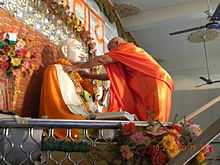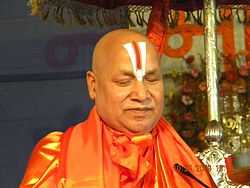Tulsi Peeth
| Tulsi Peeth Seva Nyas | |
|---|---|
|
Rambhadracharya garlanding a statue of Tulsidas at Tulsi Peeth, Chitrakoot, India, on 25 October 2009. | |
| Founder(s) | Jagadguru Rambhadracharya |
| Established | 1987 |
| President | Gita Devi Mishra |
| Location |
Chitrakoot, Madhya Pradesh, India (25°9′48″N 80°52′3″E / 25.16333°N 80.86750°ECoordinates: 25°9′48″N 80°52′3″E / 25.16333°N 80.86750°E) |
| Address | Aamodvan, Post Naya Gaon, Chitrakoot, Satna – 485331, Madhya Pradesh, India |
| |
This article is part of a series on Rambhadracharya |
|---|---|
Tulsi Peeth Seva Nyas (Hindi: तुलसी पीठ सेवा न्यास, ISO Transliteration, IPA: [Tulasī Pīṭha Sevā Nyāsa] ?, literally Service trust at the seat of Tulsi) is an Indian religious and social service institution based at Janki Kund, Chitrakoot, Madhya Pradesh. It was established by the Hindu religious leader Jagadguru Rambhadracharya on August 2, 1987.[1][2] Rambhadracharya believes that this Peeth is situated at the place where the Hindu god Rama gave his sandals to his brother Bharat.
The Tulsi Peeth premises house the residence of Rambhadracharya, a temple known as Kanch Mandir with an attached hall called Raghav Satsang Bhavan, a small cow-pen, a school for visually disabled students, a temple known as the Manas Mandir which has the entire Ramcharitmanas engraved on its inside walls, and an exhibition of moving models from 16 scenes of Ramcharitmanas.[2][3] There is also a hostel for students of Jagadguru Rambhadracharya Handicapped University (JRHU).
The activities of the Tulsi Peeth include study and propagation of Hindu religious texts in Sanskrit and Hindi, service of cows and Sadhus, publication of a monthly magazine, and organization of camps providing aids to for persons with disability.[3] The institution has published various books authored by Rambhadracharya.[4][5]
Foundation
In 1983, Rambhadracharya (then known as Rambhadradas) undertook his second six-month Payovrata, taking a diet of only milk and fruits and speaking only Sanskrit, at the Sphatik Shila in Chitrakoot. The Yuvraj of Chitrakoot, Hemraj Singh Chaturvedi, was impressed by Rambhadracharya and donated a 60 feet by 80 feet land area situated besides the Mandakini river at Janki Kund to Rambhadradas.[6] Gita Devi, Rambhadradas's elder sister, persuaded him to get an Ashram built on this plot. Rambhadradas got four rooms constructed there and started visiting the place frequently. He undertook a nine-month Payovrata at this newly built Ashram in 1986. He also started performing his Kathas there.[6] Ramcharandas Phalahari, the Sampradaya Guru of Rambhadradas, wanted Rambhadradas to stay with him at his Ashram in Prayag, but Rambhadradas was reluctant. In 1988, Umacharan Gupta, a businessman from Manikpur offered to build a bigger Ashram and a temple on the condition that Rambhadradas stay there permanently.[6] Rambhadradas agreed and the construction started. On 11 March 1987, the Kanch Mandir (literally glass-temple) was opened and Rambhadradas started living permanently in Chitrakoot. Following this, on the occasion of Tulsi Jayanti on August 2, 1987, he established Tulsi Peeth at the site of the Ashram. As the founder of the seat of Tulsi, the title of Śrīcitrakūṭatulasīpīṭhādhīśvara (literally The Lord of the Tulsi Peeth at Chitrakoot) was bestowed upon Rambhadracharya by Sadhus and intellectuals.[6] Rambhadracharya believes that this Peeth is situated at the place where, according to the epic Ramayana, the Hindu god Rama gave his sandals to his brother Bharat.[7]
Buildings
The Tulsi Peeth runs the following temples and buildings on its premises:
- The Raghav Satsang Bhavan, popularly known as Kanch Mandir, is a temple with three peaks, along with an attached hall, built in 1987. The presiding deities are Rama, Sita and Lakshmana.[7] To the south of the main temple is a small temple devoted to Hanuman.[7] There are idols of Ramanandacharya, Valmiki and Tulsidas in the temple.[3] All the windows and doors of the temple are made in glass. On the walls of the attached hall, the scenes from Ramcharitmanas are displayed in glass paintings, along with twenty-four incarnations of Vishnu as per the Bhagavata Purana.[7]
- The Tulsi School for the Blind is a school for visually disabled students, established by Rambhadracharya on 23 August 1996.[2][8] The students are provided with free education, boarding, lodging, clothes and food. Apart from school education, they are given vocational training.[3]
- The Sitaram Gaushala is a small cow-pen where some cows are reared and cared for.[3]
- The Manas Mandir is a temple with the entire Ramcharitmanas, as per the Tulsi Peeth edition, engraved on its walls. Constructed in 2008, it is situated at the entrance of the Tulsi Peeth, having a statue of saint Tulsidas in the centre.[9] Kathas by Rambhadracharya are regularly held at the Manas Mandir.[10][11][12]
- The Manas Bhavan is an exhibition of 16 scenes from the Ramcharitmanas, established in 2011.[13] It was opened to the public on January 9, 2011 by Rambhadracharya. Hamsadevanand, the Ramanandacharya from Uttarakhand said at the inauguration that the Manas Bhavan will attract tourists and will leave a permanent impression on Chitrakoot.[13] The idols in the exhibits are set into motion by electricity. Out of the 16 exhibits, six are from Bal Kand, three each from Ayodhya Kand and Aranya Kand.[13] It is situated above the Manas Mandir, but a separate entrance outside Tulsi Peeth's premises exists.[9]
- The Darshan is a two-storey building. The ground floor serves as the office of Tulsi Peeth and a room for Rambhadracharya's students.[9] The first floor is the Residence of Rambhadracharya.[9]
Two guest houses also exist in Tulsi Peeth, namely Bhakti and Shraddha. The first also serves as the house of B. Pandey, the vice-chancellor of JRHU.[9] A hostel for students of JRHU is also there.[1]
Activities
Tulsi Peeth is engaged in the following social, cultural and spiritual activities:[3]
- Study and propagation of Ramcharitmanas, and other works of Tulsidas.
- Study and propagation of Vedic and post-Vedic Indian literature, including Puranas, Upanishads, Bhagavad Gita, Bhagavata Purana, works on logic and other Sanskrit and Hindi literature.
- Service to cows and Sadhus
- Publication of the monthly magazine Shri Tulsi Peeth Saurabh, printed from Ghaziabad, Uttar Pradesh, and works of Rambhadracharya.
- Maintenance of the Tulsi School for the Blind.
- Organization of camps where people with disability are given free crutches, tricycles and artificial limbs. During the camps, free food and lodging is provided to the participants along with those accompanying them.[3]
Publications
Tulsi Peeth has published the following works of Swami Rambhadracharya:[4][5]
- (1987) Śrījānakīkṛpākaṭākṣastotram (श्रीजानकीकृपाकटाक्षस्तोत्रम्) – Sanskrit hymn of praise.
- (1992) Prabhu Kari Kṛpā Pā̐varī Dīnhī (प्रभु करि कृपा पाँवरी दीन्ही) – Hindi discourse.
- (1996) Ājādacandraśekharacaritam (आजादचन्द्रशेखरचरितम्) – Sanskrit minor poem on Chandrashekhar Azad.
- (1996) Śrīrāghavābhyudayam (श्रीराघवाभ्युदयम्) – Single-act Sanskrit play-poem.
- (1997) Śrīrāmabhaktisarvasvam (श्रीरामभक्तिसर्वस्वम्) – Sanskrit poem of one hundred verses.
- (1998) Śrīrāghavakṛpābhāṣyam (श्रीराघवकृपाभाष्यम्) on the Prasthanatrayi – Sanskrit and Hindi commentaries on the Brahma Sutra, Bhagavad Gita, and eleven Upanishads.
- (2000) Sarayūlaharī (सरयूलहरी) – Sanskrit minor poem on the river Sarayu.
- (2001) Laghuraghuvaram (लघुरघुवरम्) – Sanskrit minor poem on the infant form of Rama.
- (2001) Śrī Sītārāma Vivāha Darśana (श्री सीताराम विवाह दर्शन) – Hindi discourse.
- (2002) Śrīrāghavabhāvadarśanam (श्रीराघवभावदर्शनम्) – Sanskrit minor poem.
- (2005) Rāmacaritamānasa kā Śrītulasīpīṭha saṃskaraṇa (रामचरितमानस का श्रीतुलसीपीठ संस्करण) – a critical edition of the Ramcharitmanas.
References
- ↑ 1.0 1.1 Upadhyay, Rakesh (September 10, 2006). "जगद्गुरु स्वामी रामभद्राचार्य की अनूठी विकलांग सेवा" [Jagadguru Swami Rambhadracharya's unique work for disabled] (in Hindi). Panchjanya. Retrieved November 26, 2011.
- ↑ 2.0 2.1 2.2 Correspondent, Chitrakut (5 January 2011). "प्रज्ञाचक्षु की आंख बन गई बुआ जी" [Buaji became the eye of the visually impaired]. Jagran Yahoo (in Hindi). Retrieved 24 June 2011.
- ↑ 3.0 3.1 3.2 3.3 3.4 3.5 3.6 Nagar 2002, pp. 92.
- ↑ 4.0 4.1 Nagar 2002, pp. 89–90.
- ↑ 5.0 5.1 Dinkar 2008, pp. 40–43.
- ↑ 6.0 6.1 6.2 6.3 Dinkar 2008, pp. 31–32.
- ↑ 7.0 7.1 7.2 7.3 Nagar 2002, pp. 91.
- ↑ Aneja, Mukta (2005). "Shri Ram Bhadracharyaji – A Religious Head With A Vision". In Kaul, J. K.; Abraham, George. Abilities Redefined – Forty Life Stories Of Courage And Accomplishment. Delhi, India: All India Confederation of the Blind. pp. 66–68. Retrieved 25 April 2011.
- ↑ 9.0 9.1 9.2 9.3 9.4 "Tulsi Peeth". Shri Tulsi Peeth Seva Nyas. Retrieved 28 September 2012.
- ↑ "राम नाम लेने से नहीं मिलता कष्ट" [On chanting the name of Rama, one is free from all troubles] (in Hindi). Jagran Yahoo. January 6, 2009. Retrieved April 28, 2012.
- ↑ "भाइयों के प्रेम का गवाह है चित्रकूट" [Chitrakoot is witness to the fraternal love] (in Hindi). Jagran Yahoo. January 12, 2007. Retrieved April 28, 2012.
- ↑ "श्री सीता राम विवाह के आनंदित क्षणों मे झूमे भक्त" [Devotees dance in the blissful moments of the marriage of Sita and Rama] (in Hindi). Jagran Yahoo. January 12, 2011. Retrieved April 28, 2012.
- ↑ 13.0 13.1 13.2 "राम के जीवन दशर्न की झाँकी है मानस भवन" [Manas Bhavan sight is a glimpse of Ram's life] (in Hindi). Amar Ujala. January 10, 2011.
Works cited
- Dinkar, Dr. Vagish (2008). श्रीभार्गवराघवीयम् मीमांसा [Investigation into Śrībhārgavarāghavīyam] (in Hindi). Delhi, India: Deshbharti Prakashan. ISBN 978-81-908276-6-9.
- Nagar, Shanti Lal (2002). Sharma, Acharya Divakar; Goyal, Siva Kumar; Susila, Surendra Sharma, eds. The Holy Journey of a Divine Saint: Being the English Rendering of Swarnayatra Abhinandan Granth (First, Hardback ed.). New Delhi, India: B. R. Publishing Corporation. ISBN 81-7646-288-8.
External links
| Wikimedia Commons has media related to Tulsi Peeth. |
- Official Website of Jagadguru Rambhadracharya, run by Tulsi Peeth Seva Nyas
- Manas Darshan exhibits at Tulsi Peeth on YouTube
| ||||||||||||||||||||||||||||

